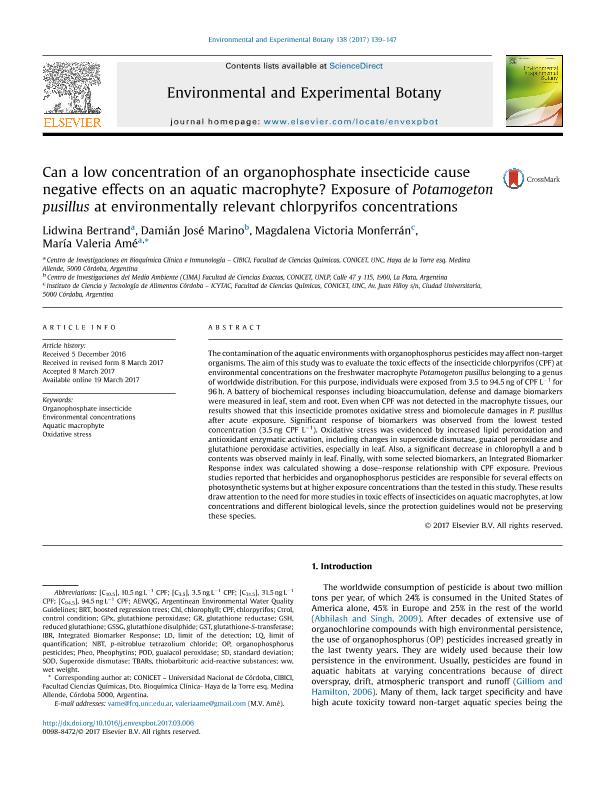Artículo
Can a low concentration of an organophosphate insecticide cause negative effects on an aquatic macrophyte? Exposure of Potamogeton pusillus at environmentally relevant chlorpyrifos concentrations
Bertrand, Lidwina ; Marino, Damian Jose Gabriel
; Marino, Damian Jose Gabriel ; Monferran, Magdalena Victoria
; Monferran, Magdalena Victoria ; Amé, María Valeria
; Amé, María Valeria
 ; Marino, Damian Jose Gabriel
; Marino, Damian Jose Gabriel ; Monferran, Magdalena Victoria
; Monferran, Magdalena Victoria ; Amé, María Valeria
; Amé, María Valeria
Fecha de publicación:
06/2017
Editorial:
Pergamon-Elsevier Science Ltd
Revista:
Environmental and Experimental Botany
ISSN:
0098-8472
Idioma:
Inglés
Tipo de recurso:
Artículo publicado
Clasificación temática:
Resumen
The contamination of the aquatic environments with organophosphorus pesticides may affect non-target organisms. The aim of this study was to evaluate the toxic effects of the insecticide chlorpyrifos (CPF) at environmental concentrations on the freshwater macrophyte Potamogeton pusillus belonging to a genus of worldwide distribution. For this purpose, individuals were exposed from 3.5 to 94.5 ng of CPF L−1 for 96 h. A battery of biochemical responses including bioaccumulation, defense and damage biomarkers were measured in leaf, stem and root. Even when CPF was not detected in the macrophyte tissues, our results showed that this insecticide promotes oxidative stress and biomolecule damages in P. pusillus after acute exposure. Significant response of biomarkers was observed from the lowest tested concentration (3.5 ng CPF L−1). Oxidative stress was evidenced by increased lipid peroxidation and antioxidant enzymatic activation, including changes in superoxide dismutase, guaiacol peroxidase and glutathione peroxidase activities, especially in leaf. Also, a significant decrease in chlorophyll a and b contents was observed mainly in leaf. Finally, with some selected biomarkers, an Integrated Biomarker Response index was calculated showing a dose–response relationship with CPF exposure. Previous studies reported that herbicides and organophosphorus pesticides are responsible for several effects on photosynthetic systems but at higher exposure concentrations than the tested in this study. These results draw attention to the need for more studies in toxic effects of insecticides on aquatic macrophytes, at low concentrations and different biological levels, since the protection guidelines would not be preserving these species.
Archivos asociados
Licencia
Identificadores
Colecciones
Articulos(CIBICI)
Articulos de CENTRO DE INV.EN BIOQUI.CLINICA E INMUNOLOGIA
Articulos de CENTRO DE INV.EN BIOQUI.CLINICA E INMUNOLOGIA
Articulos(ICYTAC)
Articulos de INST. DE CIENCIA Y TECNOLOGIA DE ALIMENTOS CORDOBA
Articulos de INST. DE CIENCIA Y TECNOLOGIA DE ALIMENTOS CORDOBA
Articulos(INFIQC)
Articulos de INST.DE INVESTIGACIONES EN FISICO- QUIMICA DE CORDOBA
Articulos de INST.DE INVESTIGACIONES EN FISICO- QUIMICA DE CORDOBA
Citación
Bertrand, Lidwina; Marino, Damian Jose Gabriel; Monferran, Magdalena Victoria; Amé, María Valeria; Can a low concentration of an organophosphate insecticide cause negative effects on an aquatic macrophyte? Exposure of Potamogeton pusillus at environmentally relevant chlorpyrifos concentrations; Pergamon-Elsevier Science Ltd; Environmental and Experimental Botany; 138; 6-2017; 139-147
Compartir
Altmétricas



